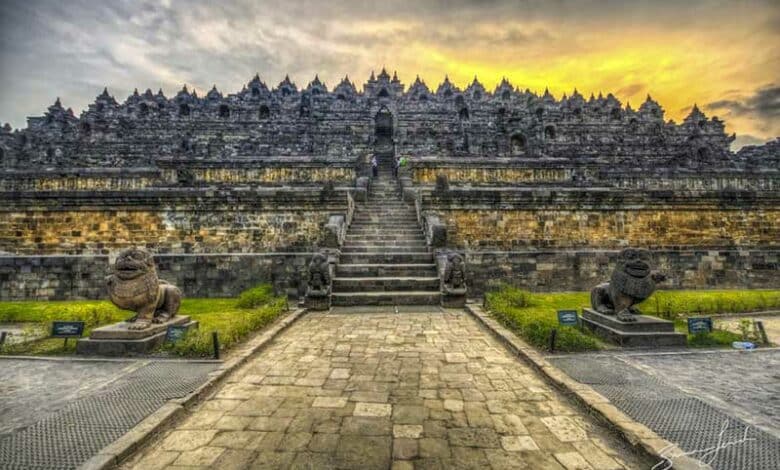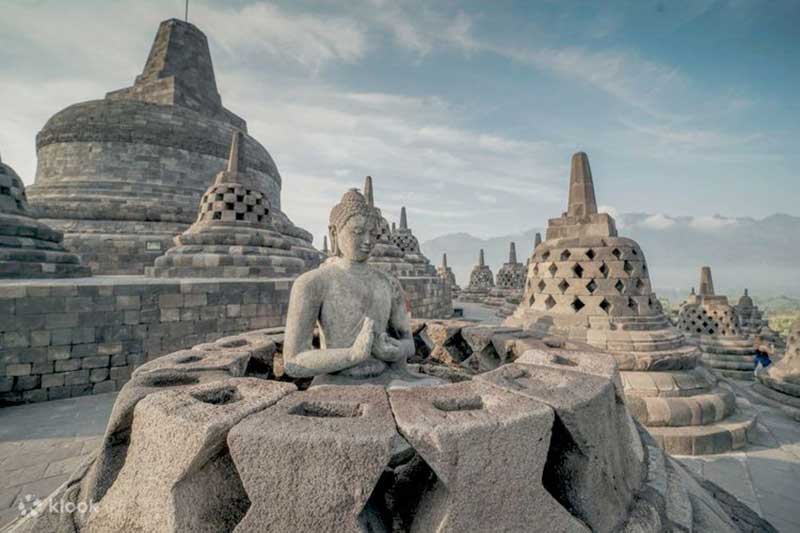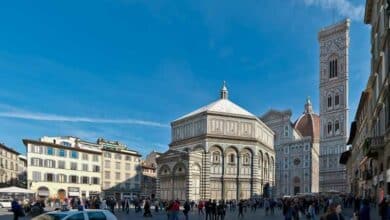Unveiling Interesting Facts About Borobudur Temple

Welcome to our exploration of Borobudur Temple – a remarkable ancient structure nestled in the heart of Indonesia. In this article, we will delve into the history, architecture, and spiritual significance of this UNESCO World Heritage Site. Prepare to be amazed by the captivating facts that make Borobudur Temple a must-visit destination for history enthusiasts and cultural aficionados alike.
As we uncover the mysteries of Borobudur Temple, you’ll learn about its rich historical background, the intricate design that sets it apart, and the profound spiritual traditions associated with this remarkable place of worship. From its colossal size to its breathtaking carvings, each detail adds to the allure of this iconic Buddhist temple.
Join us on this journey of discovery as we unlock the secrets and fascinating facts that make Borobudur Temple a true treasure of Indonesia. Are you ready to embark on an adventure through time and immerse yourself in the awe-inspiring beauty of this ancient marvel? Let’s begin!
Key Takeaways:
- Experience the captivating history and architectural wonders of Borobudur Temple.
- Discover the spiritual significance and rituals associated with this sacred Buddhist site.
- Uncover lesser-known facts about the world’s largest Buddhist temple.
- Appreciate the remarkable restoration efforts that have preserved Borobudur Temple.
- Immerse yourself in the cultural richness of Indonesia through this ancient masterpiece.
Rich History of Borobudur Temple
The Borobudur Temple, located in Central Java, Indonesia, holds a rich history that spans over a thousand years. It stands as a testament to the region’s vibrant cultural heritage and architectural excellence.
Built between the 8th and 9th centuries during the Syailendra dynasty, Borobudur Temple is a masterpiece of Mahayana Buddhism. It was constructed to symbolize the journey of a devout Buddhist towards enlightenment.
Designated as a UNESCO World Heritage site in 1991, Borobudur Temple is revered for its historical, cultural, and religious significance. The UNESCO recognition has helped to protect and preserve this magnificent structure for future generations.
Over the years, Borobudur Temple has undergone several restoration efforts to maintain its ancient splendor. One of the most extensive restoration projects took place from 1975 to 1982, funded by the Indonesian government and supported by UNESCO. This restoration project aimed to address structural issues and restore the intricate carvings and reliefs that adorn the temple’s walls.
“Borobudur Temple is not just a historical landmark; it is a representation of the spiritual journey and cultural complexity of Indonesia. Its restoration efforts highlight the country’s commitment to preserving its cultural heritage.”
The remarkable restoration of Borobudur Temple is a testament to the dedication and expertise of artisans, craftsmen, and archaeologists who worked tirelessly to ensure the preservation of this iconic site. Today, visitors can marvel at the temple’s magnificent architecture, immerse themselves in its rich history, and gain a deeper understanding of the cultural heritage it embodies.
UNESCO World Heritage Sites in Indonesia
| Site Name | Location | Year of Inscription |
|---|---|---|
| Borobudur Temple | Central Java | 1991 |
| Prambanan Temple | Central Java | 1991 |
| Komodo National Park | East Nusa Tenggara | 1991 |
| Ujung Kulon National Park | West Java | 1991 |
Magnificent Architecture of Borobudur Temple
When it comes to architectural marvels, Borobudur Temple stands in a league of its own. This magnificent structure, located in Indonesia, showcases a remarkable blend of artistic mastery and spiritual symbolism. The temple’s architecture is a testament to the ingenuity of the ancient builders and their deep understanding of Buddhist principles.
At the heart of Borobudur Temple’s design is a distinctive pyramid-shaped structure adorned with intricate carvings. The temple consists of nine stacked platforms, symbolizing the stages on the path to enlightenment. Each level is meticulously crafted and decorated with panels depicting various scenes from the life of Buddha and other Buddhist teachings.
One of the most awe-inspiring features of Borobudur Temple is the gallery that surrounds the central structure. This gallery is adorned with over 2,600 relief panels, showcasing intricate carvings of heavenly beings, mythical creatures, and everyday scenes from ancient Javanese life. These carvings provide a glimpse into the rich cultural heritage of the region and offer valuable insights into the beliefs and values of the time.
Another striking aspect of Borobudur Temple’s architecture is the plethora of Buddha statues found throughout the complex. A total of 504 Buddha statues, each seated inside perforated stupas, can be found within the temple’s walls. These statues are meticulously adorned with fine details, such as facial expressions and hand gestures, which symbolize different aspects of Buddhist teachings.
The entire architecture of Borobudur Temple is imbued with symbolic representations that resonate with visitors to this day. From the geometric precision of its structure to the ethereal beauty of its carvings, every element of the temple invites contemplation and serves as a gateway to a deeper spiritual understanding.
| Architectural Features | Description |
|---|---|
| Pyramid-Shaped Structure | A distinctive nine-tiered pyramid design representing the path to enlightenment. |
| Intricate Carvings | Over 2,600 relief panels depicting scenes from the life of Buddha and ancient Javanese life. |
| Buddha Statues | 504 Buddha statues seated inside perforated stupas, each symbolizing different aspects of Buddhist teachings. |
Visiting Borobudur Temple is a truly awe-inspiring experience. The remarkable architecture, intricate carvings, and symbolic representations found throughout this magnificent structure transport visitors to a bygone era of spiritual devotion and artistic mastery.
Spiritual Significance of Borobudur Temple
Steeped in spiritual significance, Borobudur Temple stands as a testament to the profound connection between Buddhism and the ancient Javanese culture. This majestic site holds great importance for Buddhists worldwide and serves as a place of pilgrimage, meditation, and enlightenment.
The temple, built in the 9th century, represents the Buddhist cosmology, with its three levels symbolizing various states of existence. The base represents the earthly realm, the middle level signifies the realm of desires, and the top level represents the realm of forms, where enlightenment is attained.
As an architectural marvel, Borobudur Temple showcases the concept of the Buddhist universe, with intricate carvings, statues, and reliefs that depict Buddhist teachings and stories, inviting visitors to explore the rich tapestry of Buddhist philosophy.
“To understand Borobudur is to understand the essence of Buddhism, as the temple illustrates the path to enlightenment through its symbolism and design.” – Buddhist Scholar
The journey to the top of Borobudur Temple, consisting of over 2,500 relief panels and more than 500 Buddha statues, encapsulates the spiritual journey towards nirvana. The intricate carvings carefully guide visitors through the stages of life, focusing on the pursuit of enlightenment, the challenges faced, and the ultimate liberation from suffering.
Borobudur Temple’s spiritual significance is further enhanced by the surrounding natural beauty, with panoramic views of lush landscapes and picturesque mountains, creating an atmosphere of tranquility and introspection.

The Rituals and Practices
The spiritual significance of Borobudur Temple is deeply ingrained in the rituals and practices carried out by Buddhist practitioners who visit this revered site. One such ritual is the practice of walking clockwise around the temple’s circular platforms, known as Pradaksina. This meditative practice is believed to purify the mind, body, and soul, and bring about spiritual transformation.
During special Buddhist festivals, devout followers gather at Borobudur Temple to engage in prayers, meditation sessions, and chantings. These vibrant celebrations bring together people from different backgrounds and cultures, fostering a sense of unity and shared devotion.
Borobudur Temple not only offers a spiritual sanctuary but also serves as an educational center, where visitors can learn about the profound teachings of Buddhism and gain a deeper understanding of their own spiritual journeys.
The stunning Borobudur Temple, with its deep spiritual significance, continues to captivate the hearts and minds of visitors, offering an opportunity for self-reflection, connection with Buddhist teachings, and a glimpse into the eternal quest for enlightenment.
Captivating Facts About Borobudur Temple
As one of the most renowned cultural and historical landmarks in Indonesia, Borobudur Temple is filled with captivating facts that highlight its grandeur and significance. Let’s explore some lesser-known details about this magnificent site:
- Massive Size: Standing tall with a height of 115 feet, Borobudur Temple is an architectural marvel that covers an area of over 48,000 square meters. Its sheer size makes it the largest Buddhist temple in the world.
- Impressive Preservation: Despite being built in the 9th century, Borobudur Temple has remarkably withstood the test of time. Its intricate stone carvings and structures have been well-preserved, allowing visitors to marvel at the exquisite craftsmanship of ancient artisans.
- Unique Architecture: The temple’s design reflects a fusion of Buddhist and Javanese architectural styles, featuring nine stacked platforms adorned with more than 2,600 relief panels and 500 Buddha statues. Each level represents a stage in the journey towards enlightenment.
- A Symbolic Journey: Exploring Borobudur Temple is like embarking on a spiritual journey. The temple’s structure symbolizes the Buddhist cosmos, with its base representing the earthly realm and the top representing the realm of enlightenment.
- A UNESCO World Heritage Site: Borobudur Temple’s cultural and historical significance has been recognized by UNESCO, earning it a place on the prestigious World Heritage list. This recognition further highlights its importance as a masterpiece of human creativity and ingenuity.
These captivating facts about Borobudur Temple underscore its status as not only an architectural wonder but also a testament to Indonesia’s rich cultural heritage. Exploring this ancient Buddhist monument promises an awe-inspiring experience that leaves a lasting impression.
Conclusion
Throughout this article, we have uncovered the fascinating history and captivating facts about Borobudur Temple, a cultural treasure nestled in the heart of Indonesia. With its rich history, remarkable architecture, and spiritual significance, Borobudur Temple stands as a testament to the vibrant heritage of this beautiful country.
Built in the 9th century, Borobudur Temple holds UNESCO World Heritage status and is a prime example of ancient Buddhist architecture. Its intricate carvings, symbolic representations, and unique design leave visitors in awe of the craftsmanship and devotion that went into its creation.
As a sacred Buddhist site, Borobudur Temple holds immense spiritual significance. The rituals and practices associated with this temple offer visitors a chance to connect with their inner selves and experience a sense of tranquility in this serene environment.
With its massive size and impressive preservation, Borobudur Temple stands as the largest Buddhist temple in the world and a testament to human ingenuity. This architectural marvel has not only survived the test of time but continues to inspire and captivate all who have the privilege of visiting.
Discover How Far Phuket Is From Bangkok – Your Ultimate Guide
FAQ
What is the history of Borobudur Temple?
Borobudur Temple is a historical monument that dates back to the 9th century. It was built during the reign of the Sailendra Dynasty, who were devout followers of Mahayana Buddhism. The temple remained hidden and abandoned for centuries until it was rediscovered in the 19th century by Sir Thomas Stamford Raffles, the then-governor of Java.
Why is Borobudur Temple considered a significant UNESCO World Heritage site?
Borobudur Temple is recognized and protected by UNESCO as a World Heritage site due to its outstanding universal value. It is considered one of the most important Buddhist sites in the world and is a testament to the remarkable artistry and architectural achievements of the ancient civilizations in Indonesia.
Has Borobudur Temple undergone any restoration?
Yes, Borobudur Temple has undergone several restoration efforts over the years to ensure its preservation. The first large-scale restoration project took place in the early 20th century, while significant restoration work was carried out between 1973 and 1983 through the collaborative efforts of the Indonesian government and UNESCO.
What architectural features make Borobudur Temple unique?
Borobudur Temple stands out for its distinctive architectural design, consisting of nine stacked platforms, three circular terraces, and a central dome. The temple is adorned with over 2,500 intricate relief panels and 504 Buddha statues, each showcasing remarkable attention to detail and symbolism.
What is the spiritual significance of Borobudur Temple?
Borobudur Temple holds deep spiritual significance as a sacred Buddhist site. It is believed to represent the Buddhist cosmology, with the journey towards enlightenment depicted through its intricate reliefs and symbolic structures. The temple also serves as a pilgrimage destination for Buddhists from around the world.
What are some interesting facts about Borobudur Temple?
Borobudur Temple is the world’s largest Buddhist temple and one of the most visited tourist attractions in Indonesia. It is built entirely without the use of cement or mortar, with interlocking stones providing its immense stability. Additionally, the temple’s construction is aligned with the cardinal directions, emphasizing its importance as a sacred site.




